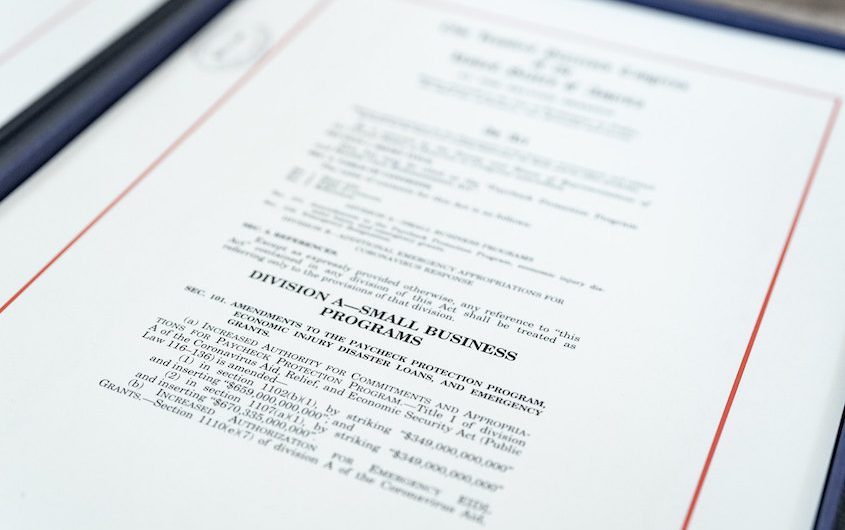
Trump White House Archived via Flickr
Labor and Social Welfare Policies in Response to the COVID-19 Pandemic

Ines Wagner
Norwegian Institute for Social Research
Ines Wagner is Research Professor at the Institute for Social Research in Oslo, Norway. Her research focuses on equal pay for work of equal value, the double mobility of capital and labour in the European single market, and technological change and the quality of work. She has held fellowships at the American Institute for Contemporary German Studies at Johns Hopkins in Washington, the Max Planck Institute for the Study of Societies in Cologne, and the European University Institute in Florence. Professor Wagner has published with, amongst others, Cornell University Press and in popular media outlets such as The Guardian and Harvard Business Review.
Germany and the United States Compared
The impact of the COVID-19 pandemic and the widespread standstill of substantial parts of the economy have had an unprecedented impact on businesses and jobs throughout the world [1][2]. The German and U.S. economies were hit hard by COVID-19. In Germany GDP dropped by 2.3 percent in the first quarter of 2020, and this was followed by a 9.7 percent fall in the second quarter [3]. The summer months allowed some economic recovery but over the entire year economic output declined by 5.5 percent [4]. The United States recorded its steepest quarterly drop in economic output on record, a decrease of 9.1 percent in the second quarter of 2020 [5]. Accordingly, certain actions were taken to lend support to companies and workers to adapt to and overcome the short-to medium-term public health and economic impact of the COVID-19 outbreak.
In Germany, the COVID-19 response was shaped by the so-called Grand Coalition government consisting of the Christian Democratic Union and the Social Democratic Party. The most well-known crisis policy response, already in place pre-pandemic, is the policy of short-time work (Kurzarbeit). Under this policy, employers are allowed to reduce their employees’ working time while workers receive the equivalent of unemployment benefits. Workers receive a replacement rate of 67 percent for those with children and 60 percent for those with no dependents for the hours they are not working [6]. Faced with the challenge of COVID-19 and the health and economic crisis it induced, the policy was not deemed sufficient. As a result, short-time work arrangements were temporarily changed. Employees would now receive 70–77 percent from the fourth month and 80–87 percent from the seventh month, with the timespan of support extended from one to two years. Not only were the percentage and time span extended, but the policy tool was adjusted to certain needs and groups of the labor market. For example, administrative changes made access to short-time work easier, particularly for service sector jobs. Short-time work emerged and was tailored to support workers in the export-oriented manufacturing sector. Now, the scheme was also extended to temporary agency workers. During the financial crisis of 2008/9, 1.5 million workers were on short-time work [7]. In May of 2020, the number of workers on short-time work peaked at 7.3 million [8].
While certain adjustments have been made to protect the increasingly larger group of peripheral workers (outside the core permanent employment relationship) in Germany, a number of inequities are noticeable. First, most workers in the female-dominated service sector are not covered by substantial collective bargaining agreements and therefore fall outside of the scope of short-time work schemes. Second, Germany’s system of joint spousal taxation results in a situation where married women on short-time work receive lower levels of support because they have to pay higher taxes on “their” earnings when their spouses earn a higher income (this translates into lower net salaries, which form the basis for calculating short-time work allowances) [9]. Third, women make up over 60 percent of workers in so-called marginal employment, an employment group that is not eligible for the short-time work scheme. Unsurprisingly, then, short-time work is less prevalent in low-income groups and, equally unsurprisingly, unemployment amongst the low-waged and marginally employed during the pandemic has been higher than for middle-and high-income employees. To address this issue, proposals were made for a minimum short-time work allowance but they were rejected by the Grand Coalition government [10]—the consequence being that social protection for women in particular has been weaker.
In the United States the Paycheck Protection Program (PPP) was the main response to the COVID-19 induced economic crisis and resulting increases in unemployment. The funds for the U.S. PPP and Germany’s short-time work schemes are different in size and structure. Compared to Germany’s short-time work scheme, the U.S. program is more generous as it pays 100 percent of employees’ earnings up to $100,000 to the firms it helps. However, key structural differences may explain why the U.S. measure was less successful in reducing unemployment. First, PPP loans are designed to cover payroll and operating costs, while short-time work in Germany covers only payroll costs. U.S. firms can thus use the funds for additional purposes while German firms must use them for payroll costs (and draw on other government loans for operating costs). Second, the PPP was initiated together with another aid package that expanded unemployment benefits (an additional $600 per week) with the result that these two programs compete. Workers with lower salaries may find the newly created unemployment benefits more attractive than the PPP’s support. Third, the PPP is administered by private banks that manage a limited pool of funds, leaving banks to decide who gets the money and who does not. In Germany, short-time work is a general legal entitlement and is administered by the government that has to fund all qualified firms by immediately subsidizing wages [11]. In sum, Germany already had a government infrastructure in place to administer the adjustments to short-time work. In the United States, the reliance on the private sector to administer the program posed a delay that could lead to businesses having to lay off workers before PPP funds become available.
References
[1] ILO. 2021. World Employment and Social Outlook: Trends 2021. Geneva, Switzerland: ILO.
[2] ILO and OECD. 2020. Social Dialogue, Skills and COVID-19: The Global Deal for Decent Work and Inclusive Growth Flagship Report. Geneva, Switzerland: ILO.
[3] DESTATIS. (2021). Statistics related to COVID-19: Economic impacts. https://www.destatis.de/EN/Themes/Cross-Section/Corona/Economy/context-economy.html.
[4] OECD. (2020). OECD economic surveys. OECD.
[5] Bauer et al https://www.brookings.edu/research/ten-facts-about-covid-19-and-the-u-s-economy/
[6] Schulten T., & Müller T. (2020). Kurzarbeitergeld in der Corona-Krise: Aktuelle Regelung in Deutschland und Europa. WSI Policy Brief.
[7] Eichhorst W., & Rinne U. (2020). Germany (December 2020), IZA covid-19 crisis response monitoring. IZA Institute of Labor Economics.
[8] KPMG. (2020). Government and institution measures in response to COVID-19: Germany. https://home.kpmg/xx/en/home/insights/2020/04/germany-government-and-institution-measures-in-response-to-covid.html.
[9] Hammerschmid A., Schmieder J., & Wrohlich K. (2020). Frauen in Corona-Krise stärker am Arbeitsmarkt betroffen als Männer. DIW Aktuell, 42 (7).
[10] Sell S.(2020). Neuigkeiten aus dem Land der Kurzarbeit: Über einen “hart errungenen Kompromiss der Koalition” – und mindestens ein großes Fragezeichen. https://aktuelle-sozialpolitik.de/2020/04/24/neuigkeiten-aus-dem-land-der-kurzarbeit/.
[11] Hassel, A. and K. THelen (2021). Unlike the US, Europe has kept during the pandemic unemployment down: https://www.hertie-school.org/en/news/detail/content/unlike-the-us-europe-has-kept-pandemic-unemployment-down
[12] Wolf. 2020: https://www2.deloitte.com/xe/en/insights/economy/short-time-work-amid-covid-19.html







